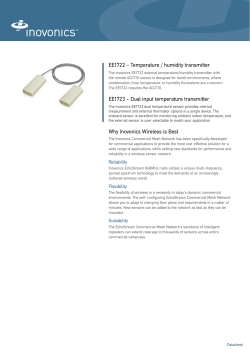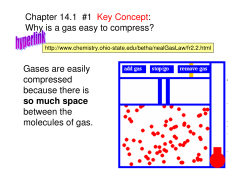
Nemoto Sensor Engineering Company Ltd
Nemoto Sensor Engineering Company Ltd Nemoto (Europe) B.V. Burgemeester Haspelslaan 53 1181NB Amstelveen The Netherlands Tel +31 20 670 3858 Fax +31 20 670 2709 www.nemoto.eu Operating Characteristics and Handling Manual for the NAP-56A Explosive/Flammable Gas Sensor The Nemoto NAP56A is a new, improved low cost catalytic flammable gas sensor. Closely related to the very popular NAP-55A sensor, the NAP-56A uses exactly the same sensing elements, but the enclosure in which they are mounted employs a nickel plated brass mounting cap and a phenolic resin header, instead of the Nylon 66 material used in the NAP55A. As a result, the sensor exhibits an increased sensitivity output and an increase in useful temperature range, whilst being very slightly larger in dimensions, compared to the NAP-55A. The widened temperature range of the NAP-56A makes it particularly suitable for applications such as recreational vehicles, caravans and marine applications where a wide temperature range is required. The mechanical construction and technical performance of this sensor makes it also suitable for a wide variety of Industrial and commercial gas detection applications. Nemoto has a policy of continuous development and improvement of its products. As such the specification for the device outlined in this document may be changed without notice. NAP-56A Handling Manual, Issue 2, Aug 2014 Page 1 of 11 Contents Principles of Operation………………………………………………………………….….. 3 General Specifications…………………………………………………….……. 4 Outline Drawing, Dimensions and Materials of Construction…………… 5 Performance Measurements…………………………………………………… 6 Gas Sensitivity…………………………………………………………………………….. 6 Temperature Dependence………………………………………………………………. 7 Humidity Dependence…………………………………………………………………… 8 Long Term Stability…………………………………………………………………….... 9 Relative Responses to Various Gases………………………………………………. 10 Notes on Sensor Testing……………………………………………………….. 11 Note that the Performance measurements expressed in this document should be considered as typical characteristics for guidance only, and not as specifications which are guaranteed, apart from those in the sections ”General Specifications” and “Dimensions” (Pages 4 and 5). It is the instrument designer’s responsibility to ensure that the sensor is suitable for any given application. NAP-56A Handling Manual, Issue 2, Aug 2014 Page 2 of 11 Principles of Operation: Catalytic combustion has been the most widely used method of detecting flammable gases in Industry since the invention of the catalysed pelletized resistor (or "Pellistor") over 40 years ago. A Pellistor consists of a very fine coil of platinum wire, embedded within a ceramic pellet. On the surface of the pellet is a layer of a high surface area noble metal, which, when hot, acts as a catalyst to promote exothermic oxidation of flammable gases. In operation, the pellet and so the catalyst layer is heated by passing a current through the underlying coil. In the presence of a flammable gas or vapour, the hot catalyst allows oxidation to occur in a similar chemical reaction to combustion. Just as in combustion, the reaction releases heat, which causes the temperature of the catalyst together with its underlying pellet and coil to rise. This rise in temperature results in a change in the electrical resistance of the coil, and it is this change in electrical resistance which constitutes the signal from the sensor. Pellistors are always manufactured in pairs, the active catalysed element being supplied with an electrically matched element which contains no catalyst and is treated to ensure no flammable gas will oxidise on its surface. This "compensator" element is used as a reference resistance to which the sensor's signal is compared, to remove the effects of environmental factors other than the presence of a flammable gas. Pellistor Drive/Measurement Circuit: A simple Wheatstone Bridge to compare the resistance of two hot elements NAP-56A Handling Manual, Issue 2, Aug 2014 Page 3 of 11 The advantage of using this technique when detecting flammable gases for safety purposes is that it measures flammability directly. Nemoto provides matched pair Pellistors conveniently mounted in a variety of enclosures for different applications. Some of these options contain the detector and compensator elements in separate enclosures (the NP range for Industrial applications). In the case of the NAP-56A, both elements are contained within a plastic enclosure for ease of use and low cost. Catalytic pellistor type gas sensors have many advantages compared with semiconductor type gas sensors Linear output in proportion to gas concentration Greater Stability Higher reproducibility Gas specific - will only respond to flammable gases Unaffected by humidity Stable output for long periods More resistant to shocks and vibrations. General Specifications: Operating Specifications: Detected Gases Standard Concentration Range Recommended Bridge Voltage Current Consumption (at Recommended Bridge Voltage) Bridge zero offset Output Sensitivity Linearity Response Time (Measured as T90) Flammable Gases (All specifications are based on the detection of Methane/Natural Gas) 0 – 2.5% Methane in Air (0-50% LEL) 2.5V +/- 0.25V 170mA +/- 10mA 0 +/- 35mV 15-23 mV for 3000ppm CH4 Effectively Linear to 50% LEL <10 secs ± 0.5mV for Zero ± 0.5mV for Gas Sensitivity Zero: Less than +/- 2mV per year Sensitivity: Less than +/- 2mV per Month Over 5 Years. (In an appropriate Residential or Light commercial application) Accuracy (Measured as Repeatability) Long Term Stability Drift Expected Lifetime in the field Environmental Specifications: Temperature Range Standard constant Humidity Range Standard Constant Pressure Range Recommended storage Temperature Range Recommended Maximum Storage Time -30°C to +70°C 15 to 90%RH 1atm ± 10% 0 to 20 degree C 6 months Mechanical Data Enclosure Material Connector Pin Material Header (Base) Material Protective Mesh Material Nickel Plated Brass Nickel Phenolic Resin 316 SS NAP-56A Handling Manual, Issue 2, Aug 2014 Page 4 of 11 Dimensions, Structure and Materials of Construction 1 Detector Mark 3 4 NEMOTO 4 .6 13 .3 φ11 D C 3 .5 2 Compensator Mark 10 .6 8 5 7 6 5 8Mesh 7 Stra iner 6 P in 5Base mount 4 Separator 3Co i l 2Compensator 1Detector No Parts SUS316#100 Brass with Ni coat ing Ni Pheno l SUS304 Pt - - Mater ia ls Duob le t=0 .2 φ0 .8 - t=0 .2 φ0 .03 - - Remarks NAP-56A Handling Manual, Issue 2, Aug 2014 Page 5 of 11 Performance Measurements The NAP-56A sensor is derived largely from the very popular NAP-55A sensor, the only difference being in the enclosure, which is slightly larger and made from different materials to result in a device which is tolerant to a wider temperature range. The typical performance of the sensor can hence be largely taken as being very similar to the NAP55A in most respects. The chief performance difference between the two sensors is that the signal output of the NAP-56A is slightly higher than for the NAP-55A, and so the performance details given here are those which is related to this difference. Response characteristics, resistance to catalyst poisons, wind / flow rate effects and lifetime considerations can be considered to be similar to those given in the operating manual for the NAP-55A. Gas sensitivity The graph below shows the typical sensitivity characteristics for methane, hydrogen, Isobutane and Ethanol Output voltage (mV) 120 100 80 60 Hydrogen iso-Butane 40 Ethanol Methane 20 0 0 0.2 0.4 0.6 Gas concentration (%) 0.8 1 For other flammable gases, Nemoto can advise on the anticipated sensitivity of the sensor alone, but since the relative sensitivities to various gases is also dependent on the mounting arrangement within an instrument, it is always recommended that the instrument maker determines the response of the sensor to the target gas by experiment using the final product design wherever possible. NAP-56A Handling Manual, Issue 2, Aug 2014 Page 6 of 11 Temperature Dependence Zero offset drift (mV) (Drift from 25 degree C) Typical Zero Offset Drift with Temperature 10 8 6 4 2 0 -2 -40 -4 -6 -8 -10 Max. -20 0 20 40 60 Min. 80 Relative humidity : Ambient temperature (degree C) Relative sensitivity of methane (100 at 25 degree C) Typical Gas Sensitivity Drift with Temperature 120 Max. Min. 100 80 60 40 Relative humidity : 20 0 -40 -20 0 20 40 60 Ambient temperature (degree C) 80 NAP-56A Handling Manual, Issue 2, Aug 2014 Page 7 of 11 Humidity Dependence Typical Zero Offset Drift with Humidity Zero offset drift (mV) (Drift from 50%RH) 2 1.5 1 Max. 0.5 0 -0.5 0 20 40 60 80 100 Min. Temperature: 25 degree C -1 -1.5 -2 Relative humidity (%) Relative sensitivity to methane Typical Gas Sensitivity Drift with Humidity 120 Max. 100 80 Min. 60 40 Temperature: 25 degree C 20 0 0 20 40 60 Relative humidity (%) 80 100 NAP-56A Handling Manual, Issue 2, Aug 2014 Page 8 of 11 Long Term Stability Typical Long Term Zero offset Drift Zero offset drift (mV) 6 (n=8) 4 Max. Average 2 Min. 0 0 500 1000 1500 2000 -2 Elapsed time (days) Relative sensitivity to methane Typical Long Term Gas sensitivity Drift 120 100 Max. Average 80 60 Min. 40 (n=8) 20 0 0 500 1000 Elapsed time (days) 1500 2000 NAP-56A Handling Manual, Issue 2, Aug 2014 Page 9 of 11 Relative Resonses to various gases Below is a table of the NAP-56A responses to various flammable gases. The table assumes the sensor is measuring on the 0-100% LEL scale, and also assumes that the response to methane = 100% 1 2 3 4 5 6 7 Gas Methane Propane n-Butane n-Pentane n-Hexane n-Heptane n-Octane LEL Concentration (%) 5.00 2.20 1.80 1.40 1.20 1.05 0.95 Relative sensitivity 100 70 70 65 60 55 50 8 Methanol 6.70 105 9 Ethanol 3.30 75 10 Iso-Propanol 2.20 75 12 Carbon monoxide 13 Acetone 2.60 60 14 15 16 Methylethylketone Toluene Ethyl acetate 1.90 1.20 2.20 40 65 50 17 Hydrogen 4.00 110 18 Ammonia 19 20 Unleaded petrol Ethylene 12.5 15.0 1.20 2.70 110 130 60 90 NAP-56A Handling Manual, Issue 2, Aug 2014 Page 10 of 11 Notes on sensor testing All Nemoto specifications are based on testing within a gas filled chamber. Testing the sensor using a flow-through system will yield similar, but not identical, results. The Nemoto test set up is illustrated below: Gas Fan Ventilator Gas densitometer D.C. voltage stabilizer Voltmeter The test chamber should be constructed of glass, or another material known not to absorb gases. In Nemoto’s test regime, test gases are introduced into the chamber by injection, following careful calculation of the amount of gas required to generate the required concentration within the chamber. This may also be accomplished by purging the chamber using gas from a test gas cylinder, provided the flow rate used is not high enough to cause turbulence in the chamber. The gas inside the chamber should be gently agitated by a slow moving fan, to ensure that concentration gradients do not develop during testing, either by stratification layers forming in the chamber, or by the consumption of the gas by the sensors themselves. NAP-56A Handling Manual, Issue 2, Aug 2014 Page 11 of 11
© Copyright 2025









